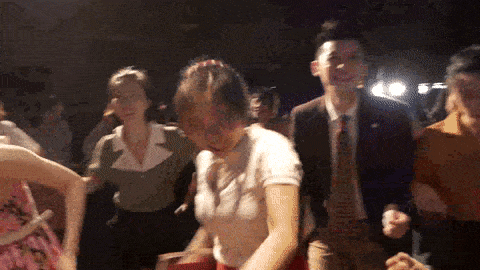
The swing dancing ambassador to China
CGTN
The 1930s marked the start of the "jazz age" in the United States. People felt free to swing their bodies to the upbeat melodies, with the earliest street dances occurring in African American communities. In the 1940s, swing dancing became popular together with the rise of big bands and eventually found a home in Hollywood.
"Actually, today's street dance evolved from swing dance," says Zeng Weiming, a swing dancer who runs his own studio in Beijing.
Zeng Weiming leads dancers on the floor /by CGTN
Zeng used to play saxophone in a big band. "It was around 2007. I really liked the swing music. The band leader asked me if I wanted to try some ballroom dances," he said.
Zeng had second thoughts at first. "Ballroom dances emerged decades ago in China, and reached the peak of popularity in the 1990s. My parents used to go out dancing, before wrong things started to happen in the dancing halls. I didn't feel right about ballroom dancing in the first place."
Zeng's stereotypes broke down when he began learning to swing dance. "There are no fixed routines or partners. You just swing your body to the music, expressing yourself without saying a word."
"When the music is on, you move your body with the rhythm. You raise your arm, turn around, or your partner leads you. It's a communication between you two," he said.
CGTN Photo
Unlike other ballroom dances, people often switch partners in a group swing dance. Participants often dance with strangers and get acquainted with each other by moving together to the music.
At first, most swing dancers in China were foreigners. Zeng joined them and practiced in a bar on Mondays after hours.
"There were fewer dancers, even less were local. I was 22, and people treated me like their little brother," Zeng said. Having practiced for less than two years, Zeng already won two domestic championships in both improvised dancing and performance. Then he began to teach.
In 2009, Zeng went abroad to dance for the first time. "I was quite poor. The dancers pooled the money for me. Some bought me the plane ticket, others paid the entrance fee for dancing parties. I got all the support to go to Korea," said Zeng. "Seeing so many swing dancers there, I wished there were as many in China." He started to think about promoting it in his homeland.
The dancers pooled their resources again in 2012 to send him to study in Europe for a month. A couple of years later, he opened his studio and set about organizing the annual Swingtime Ball.
China embraced the Swingtime Ball back in 2003. It used to be a small event with fewer than 100 participants. In 2018, it became a grand festival with over 500 guest dancers. Everyone performed and competed on and off stage. During the organization of the event, Zeng felt that he became a sort of parent, assuming responsibility for the dancers.

CGTN Photo
"I've been very lucky," said Zeng. "I didn't have really hard setbacks. I got help from people all the time. The first event was a bit difficult, but things are getting better now. While preparing for the ball, many people are willing to devote to it. Our tuner said he regained confidence through swing dance, and he'd like to be a giver. Our whole team sticks together and works hard for a common objective."
Most of the participants are younger white collar workers in office buildings. After work, however, they throw themselves willingly onto the dance floor.
"I think young people really need a touch of the swing dance culture, because it helps you communicate and express your emotions," Zeng said. "They'd rather talk to the computers than to humans, except when they have to talk to their bosses and colleagues. Then they get home and talk to their TV and cellphones. There were really few emotional communications among people."
Swing dancing offers a means of communication. Zeng hopes that more young people will join them in China, and enjoy the excitement stirred up by the lively rhythms.
This story is one in The 1.3 Billion series exploring the diverse lives that make up China.